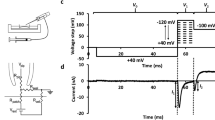Summary
Sodium azide at concentrations <−1.0 mM was capable of stimulating potassium efflux from frog sartorius muscles with no significant influence on the intracellular sodium content. At concentrations >−2.0 mM, azide produced a continuously increasing rate of potassium loss which resulted in a net loss of intracellular potassium. This effect was mimicked at low azide concentrations (<−1.0 mM) in the presence of 10−5 M strophanthidin or 1.0 mM sodium cyanide. It was independent of the intracellular sodium content, but dependent on the external sodium concentration. While increasing concentrations of azide produced incremental increases in the rate of potassium loss in sodium-reduced Ringer's solution, the continuously increasing rate of loss and strophanthidin sensitivity was absent. It is concluded that the biphasic effect of azide on potassium efflux in skeletal muscle resulted from the interaction of this agent with at least two cellular processes, one of which was dependent on the external sodium concentration.
Similar content being viewed by others
References
Abood, L. G., Koketsu, K., Noda, K.: Effect of dinitrophenol on phosphorylation and bioelectric phenomena of excitable tissues. Amer. J. Physiol.200, 431–436 (1961).
Adrian, R. H.: The effect of internal and external potassium concentration on the membrane potential of frog muscle. J. Physiol. (Lond.)133, 631–658 (1956).
—, Slayman, C. L.: Membrane potential and conductance during transport of sodium, potassium and rubidium in frog muscle. J. Physiol. (Lond.)184, 970–1014 (1966).
Carey, Mary, J., Conway, E. J., Kernan, R. P.: Secretion of sodium ions by frog's sartorius. J. Physiol. (Lond.)148, 51–82 (1959).
Cross, S. R., Keynes, R. D., Rybová, Renata: The coupling of sodium efflux and potassium influx in frog muscles. J. Physiol. (Lond.)181, 865–880 (1965).
Desmedt, J. E.: Electrical activity and intracellular sodium concentrations in frog muscle. J. Physiol. (Lond.)121, 191–205 (1953).
Haas, H. E., Hantsch, F., Otter, H. P., Siegel, G.: Untersuchungen zum Problem des aktiven K- und Na-Transport am Myokard. Pflügers Arch. ges. Physiol.294, 144–168 (1967).
Henderson, E. G.: Strophanthidin sensitivity of skeletal muscles in sodium- and potassium-free solutions. Fed. Proc.30, 2670 (1971).
—, Walkenstein, S.: Sodium azide stimulated potassium efflux from striated muscles. Pflügers Arch. ges. Physiol.326, 193–210 (1971).
Hodgkin, A. L., Horowicz, P.: Movements of Na and Ka in single muscle fibers. J. Physiol. (Lond.)145, 405–432 (1959a).
——: The influence of potassium and chloride ions on the membrane potential of single muscle fibers. J. Physiol. (Lond.)148, 127–160 (1959b).
—, Keynes, R. D.: The potassium permeability of the giant nerve fiber. J. Physiol. (Lond.)128, 61–88 (1955).
Horowicz, P., Caputo, C., Robeson, J. A.: Rapid depolarization of frog muscle membranes by NaN3. Fed. Proc.21, 151 (1962).
—, Gerber, C. J.: Effects of sodium azide on sodium fluxes in frog striated muscle. J. gen. Physiol.48, 515–525 (1965).
Kernan, R. P.: Membrane potential changes during sodium transport in frog sartorius muscle. Nature (Lond.)193, 986–987 (1962).
Keynes, R. D., Maisel, G. W.: The energy requirement for sodium extrusion from a frog muscle. Proc. roy. Soc. B142, 383–392 (1954).
Lehninger, A. L.: The mitochondrion. New York-Amsterdam: W. A. Benjamin Inc. 1965.
Ling, G., Gerard, R. W.: The membrane potential and metabolism of muscle fibers. J. cell. comp. Physiol.34, 413–437 (1949).
Myerhoff, O.: The origin of the reaction of Harden and Young in cell-free alcoholic fermentation. J. biol. Chem.157, 105–119 (1945).
Moreva, E., Podlesnaya, A.: Effect of sodium azide on the balance of high energy phosphate compounds of skeletal muscle. Trudy Inst. Eksptl. Med. Akad. Med. Nauk SSR Ezhegodink Liningrad, pp. 206–209 (1959).
Shaw, F. H., Simon, Shirely E: Sodium extrusion in muscle. Nature (Lond.)176, 1031–1032 (1955).
Sjodin, R. A.: The potassium flux ratio in skeletal muscle as a test for independent ion movement. J. gen. Physiol.48, 777–795 (1965).
—: The kinetics of sodium extrusion in striated muscle as functions of the external sodium and potassium ions. J. gen. Physiol.57, 164–187 (1971).
—, Beaugé, L. A.: Strophanthidin-sensitive components of potassium and sodium movements in skeletal muscle as influenced by the internal sodium concentration. J. gen. Physiol.52, 389–407 (1968).
—, Henderson, E. G.: Tracer and non-tracer potassium fluxes in frog sartorius muscles and the kinetics of net potassium movement. J. gen. Physiol.47, 605–638 (1964).
Teorell, T.: Membrane electrophoresis in relation to bioelectric polarization effects. Arch. Sci. Physiol.3, 205–219 (1949).
Ussing, H. H.: The distinction by means of tracers between active transport and diffusion. Acta physiol. scand.19, 43–56 (1949).
Vigers, G. A., Ziegler, R. D.: Azide inhibition of mitochondrial ATPase. Biochem. biophys. Res. Commun.30, 83–88 (1968).
Wilson, D. F., Chance, B.: Azide inhibition of mitochondrial electron transport. I. The aerobic steady state of succinate. oxidation. Biochim. biophys. Acta (Amst.)131, 421–430 (1967).
Author information
Authors and Affiliations
Rights and permissions
About this article
Cite this article
Henderson, E.G. Azide sensitive components of potassium efflux as influenced by the external sodium concentration. Pflugers Arch. 329, 95–114 (1971). https://doi.org/10.1007/BF00586985
Received:
Issue Date:
DOI: https://doi.org/10.1007/BF00586985



